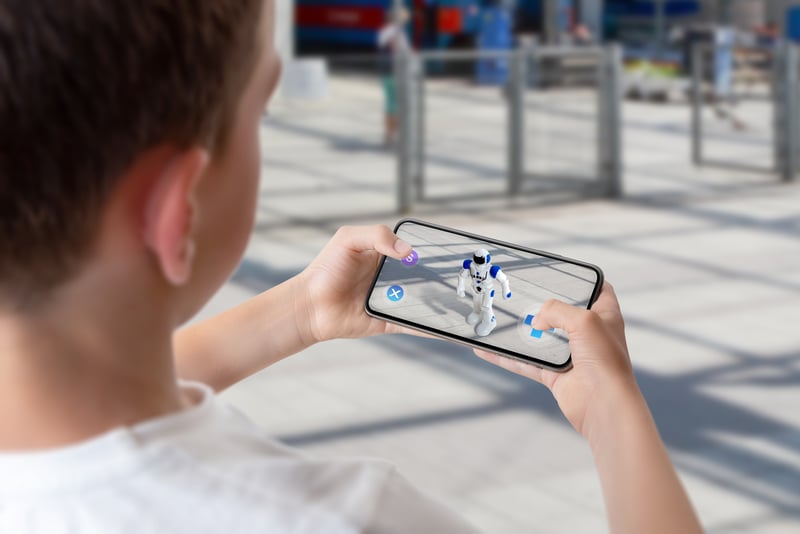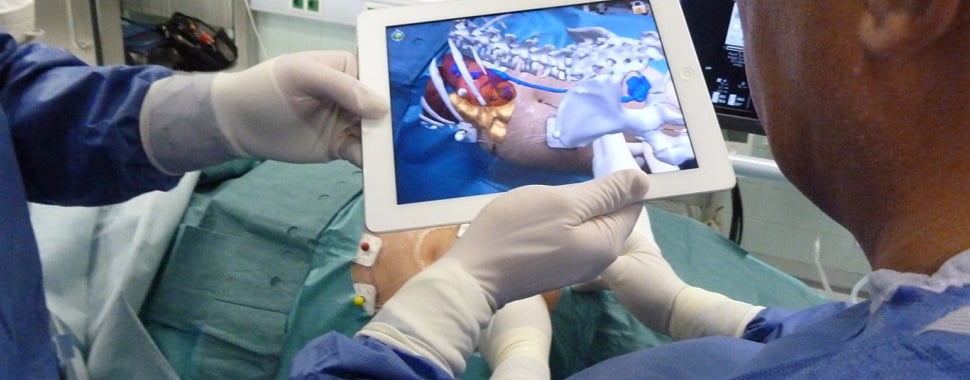Envision a world where digital information merges effortlessly with our physical environment to enhance every experience of learning, gaming, working, or shopping. This is all made possible through Augmented Reality (AR). Once considered futuristic, the technology has become a reality today and is transforming many industries globally. A technology filled with immersive and interactive capabilities, it is revolutionizing the relationship we have with the world - be it in retail, health, gaming, or education.
By 2025, AR will no longer be just an add-on; it will have evolved into a crucial element that reshapes business strategies, consumer habits, and everyday experiences. Whether you're a marketer, business owner, tech enthusiast, or simply curious about the future of AR, recent statistics highlight its rapid growth and adoption. But before we dive into the Augmented Reality statistics, let's define what "augmented reality" really means.
Augmented Reality Technology: From Early Concepts to Mainstream Innovation
Back in 1901, author L. Frank Baum envisioned a “character marker”—an electronically-powered display that could project information into the real world. Today, companies like Meta and Apple bring similar ideas to life, using passthrough cameras on advanced headsets and 3D rendering to overlay digital characters in our environment.
Augmented Reality (AR) is a technology that blends the physical and digital worlds by superimposing computer-generated visuals onto real-world objects. Through a combination of AR hardware and software, it offers users an enhanced, interactive experience that extends beyond traditional digital interfaces.
Once considered experimental and niche, AR has now become a mainstream technology. Its widespread adoption underscores the importance for brands to understand and leverage AR capabilities—or risk falling behind in an increasingly digital marketplace.
According to Skyquestt, the AR market started at a value of $32.1 billion and is projected to grow at an impressive CAGR of 33.5%. Industry forecasts suggest that by the 2030s, AR could exceed $300 billion, fueling a surge in demand for AR-driven applications across sectors such as retail, education, healthcare, and entertainment.
AR Stats at a Glance
|
Metric |
2025 Projection |
|
Global AR Market |
$50B+ |
|
Mobile AR Revenue |
$13.8B |
|
Active Mobile AR Users |
1.7B |
|
AR Gaming Market |
$141.7B by 2033 |
|
AR in Retail Purchase Intent |
+17% |
|
AR in Luxury Fashion |
72% of shoppers excited to use AR |
|
AR Impact on B2B Sales |
+35% efficiency |
Mobile AR Market Revenue and Growth
- The global mobile augmented reality market was valued at $11.9 billion in 2024 and will run to $13.8 billion in 2025. (Statista)
Mobile augmented reality (AR) market revenue worldwide from 2023 to 2028 (in million U.S. dollars)
- As per another statistic, the mobile AR market is estimated to touch $36 billion by 2026. This is quite high as compared to its scale of $12.45 billion in 2021. (Statista)
- The predictive front globally estimates the active mobile AR user devices at 1.7 billion by 2024, against 1.1 billion in 2022. (Statista)
Mobile augmented reality (AR) users worldwide from 2023 to 2028 (in millions)
With mobile devices becoming more AR-friendly, brands and developers are creating more applications that blend digital content into real-world settings. Whether it's through virtual try-ons, interactive games, or AR navigation, mobile AR is becoming a key driver of digital engagement.
AR Market Revenue and Forecast
- The global AR & VR revenue would generate revenue of about $40.4 billion in 2024, and the forecasts indicate that this figure would grow at a CAGR of 8.97% in 2024 through 2029, settling at a market volume of $62.0 billion. (Statista)
- In 2024, AR Software had the largest market volume at $13.0 billion. (Statista)
- The global AR & VR in Education Market Size was estimated at $3.8 Bn in 2023 and is predicted to reach $14.2 Bn by 2028, expanding at a CAGR of 29.6% during the projection period 2023 -2028. (Marketsandmarkets)
- The AR & VR market of healthcare is predicted to observe $10.82 billion by 2025, with the annual growth of AR technology crossing the mark of VR by 38.38%. (Businesswire)
Latest Augmented Reality Trends 2025
1. Consumer Behavior & AR in Retail
Augmented Reality is revolutionizing retail by enhancing consumer confidence, reducing product return rates, and improving online shopping experiences. Customers can now try products virtually before purchasing, leading to higher engagement and conversion rates.
- The integration of augmented reality in retail has been shown to increase consumer purchase intention by 17%. (AMA)
- 61% of consumers prefer to shop with retailers offering advanced AR experiences (Salsify)
- 71% of shoppers say they would shop more if they had access to AR (NCBI)
- 40% of consumers would be willing to pay more for a product if they could view it through AR. (Infosys Bpm)

Retailers are integrating AR-powered smart mirrors, virtual fitting rooms, and interactive 3D product displays to provide immersive shopping experiences. With consumers embracing AR shopping, businesses that adopt AR are likely to see a competitive edge and increased revenue.
2. AR in Gaming and Entertainment

- The global AR gaming market size was USD 14.2 Billion in 2024. Now, IMARC Group evaluates the market to touch USD 141.7 Billion by 2033, showing a CAGR of 25.9% from 2025-2033. (Imarcgroup)
- The mobile AR technology market in gaming exceeded $4.2 billion in 2023, and is forecasted to reach $31.5 billion in 2033. This growth is attributed to the hunt for more immersive experiences along with the technological developments. (Futuremarketinsights)
3. AR in Consumer Electronics & Hardware
The demand for AR hardware—such as AR glasses, headsets, and smart displays—is rapidly growing, with tech giants investing heavily in lightweight, user-friendly devices.
- The consumer and enterprise AR glasses market was valued at $6.4 billion in 2024, with estimates suggesting that this number could increase by more than 50% by 2025. (Statista)
- The AR Glass market is supposed to reach $883 million globally by 2025. (Businesswire)
- The global market for micro LED display chips used in AR smart glasses is expected to grow up to $41 million by 2026. (TrendForce)
4. AR in Social Media & Marketing
- When it comes to creating engagement, AR-based marketing campaigns are found to average a dwell time of 75 seconds. (Poplar Studio)
- Another one of the interesting augmented reality marketing statistics is that approximately 80% of businesses that have implemented AR lenses or filters have reported a boost in their brand awareness metrics by utilizing these devices. (Source)
- More than 85% of engaged consumers in AR/VR technologies also participate in social shopping, with Gen Z and Millennials being the most enthusiastic adopters. (Stories AR)

5. AR in Healthcare & Industry
 (Source)
(Source)- As per a study, the AR market is anticipated to grow to 29.5 (USD Billion) by 2032. A major part of its growth would have stemmed from applications for medical training, surgery planning, and care delivery. (Market Research Future)
- The global VR/ augmented reality in healthcare market revenue is anticipated to reach $14.85 Bn by the end of 2034, growing at a CAGR of 18.2% from 2024 to 2034. (Fact.MR)
6. AR in eCommerce & Fashion
Augmented Reality is redefining the online shopping experience by allowing consumers to interact with products before purchasing. Virtual try-ons, 3D previews, and interactive product experiences are eliminating the uncertainty of online shopping, leading to higher conversion rates and reduced return rates.
- 72% of luxury fashion shoppers in the UK are excited to use AR for their digital shopping experience (Source: Vogue Business and Snap Inc.)
- About 90% of Gen Zers would be willing to use AR to gain a better picture of how furniture or décor would look in their homes. (Shopify)

This increase in combined efficiency serves to show that 3D Augmented Reality advertisements can generate 94% higher conversion rates compared to static display ads. (Source)
7. AI-Driven AR Solutions
Augmented Reality (AR) powered by Artificial Intelligence (AI) makes immersive experiences more interactive and accessible. AI-driven 3D rendering enables brands to showcase products in AR without complex development, enhancing virtual try-ons, product configurators, and marketing.
- 78% of consumers prefer AI-enhanced AR experiences for real-time interaction. (Accenture)
- Retailers using AI-powered AR see a 40% increase in engagement and a 25% boost in conversion rates. (ResearchGate)
8. AI-Powered AR Personalization for E-Commerce
AI-based 3D configurators allow real-time product customization. Customers can personalize colors, materials, and designs, leading to better engagement and fewer returns.
- AR shopping experiences reduce returns by 25% to 40%. (Alliancetek)
- Brands using AI-powered AR configurators report a 20% increase in conversion rates. (ResearchGate)
9. No-Code AR for Web and Mobile
Web-based AR solutions eliminate the need for app installations, enabling customers to access AR experiences directly from their browsers.
- More than 70% of customers feel AI improves shopping by saving time and offering personalized interactions. (World Economic Forum Reports)
10. AI-driven AR for B2B Sales and Virtual Demonstrations
AR is revolutionizing B2B sales by integrating with CPQ (Configure, Price, Quote) systems. Businesses can present complex products in real-time AR, allowing interactive 3D visualizations and instant pricing.
- B2B companies implementing AR-based CPQ solutions experience a 35% increase in sales efficiency. (ResearchGate)
- 92% of B2B buyers say AR presentations improve product understanding. (ResearchGate)
11. Smart Packaging, AR Guides, and Immersive User Manuals
AR-powered packaging and user guides provide customers with interactive 3D tutorials and product information, enhancing support and engagement.
- AR-powered smart packaging leads to a 70% increase in customer interaction compared to traditional packaging. (ResearchGate)
- Brands using AR-enhanced manuals see a 45% decrease in customer service inquiries. (ResearchGate)
12. AR-Driven B2B Product Demonstrations
AI-powered AR is transforming B2B sales by enabling immersive, real-time product demonstrations. Companies can showcase complex machinery, software, or large-scale equipment through interactive 3D visualizations, reducing the need for physical prototypes and costly demos.
- 82% of B2B buyers report that AR-driven demos improve decision-making and accelerate purchase cycles. (ResearchGate)
- Companies using AR for product demonstrations see a 30% reduction in sales cycle time and a 25% increase in deal closures. (ResearchGate)
13. Augmented Reality in Consumer Shows
Augmented Reality (AR) for consumer shows is a boon. Its ability to offer immersive, interactive experiences is transforming how brands engage with audiences. Here are some key AR statistics highlighting the impact and adoption of the technology in consumer shows:
- 73% of consumers express interest in experiencing AR at events and conferences. (G2 Learn Hub)
- AR engagement has increased by nearly 20% since early 2020, with conversion rates rising by 90% for consumers interacting with AR compared to those who don't. (Reydar)
- Another statistic that shows influence of augmented reality at consumer shows is that 56% of consumers report that AR technology boosts their confidence in a product's quality, and 61% prefer shopping at retailers offering AR experiences. (Forbes Councils)
- The global AR shopping market is projected to grow from USD 4.0 billion in 2023 to USD 54.7 billion by 2033, reflecting a CAGR of 29.9%. (Market.us)
The Global Adoption & Future of AR
- Approximately 75% of the worldwide population has experienced AR technology (Deloitte)
- The total market of Augmented Reality in 2022 was approximately $31.97 billion, and it is projected to be about $88.4 billion by 2026, with a compounded annual growth of 31.5 percent from 2023 to 2026. (Marketsandmarkets)
- Augmented Reality (AR) and Virtual Reality (VR) will contribute up to $13 trillion to the global economy by 2030. (PwC)
Parting Thoughts
The above mentioned Augmented Reality statistics show that how fast this technology is evolving and integrating into various industries—from retail experiences to virtual training and remote assistance in healthcare.
As AR continues to advance, its potential to reshape workplaces, schools, retail spaces, and even social interactions is undeniable. With enhanced capabilities emerging, AR is set to redefine how we engage with the world around us.
In 2025, AR is expected to become a mainstream topic across industries, influencing business strategies and shaping consumer experiences. It will drive innovation and growth for years to come, transforming the way we interact with our environment in ways we can only begin to imagine.






.png?width=500&name=How%20to%20Add%20a%203D%20Product%20Configurator%20to%20Your%20WordPress%20Website%20(Complete%20B2B%20Guide).png)
















%20(1).png?width=500&name=Why%20Exploded%20Mattress%20Views%20Matter%20(And%20How%20to%20Generate%20Them)%20(1).png)
.png?width=500&name=Best%20Shopify%20Product%20Configurator_%20How%20to%20Choose%20the%20Right%20One%20(2).png)
.png?width=500&name=Why%20Exploded%20Mattress%20Views%20Matter%20(And%20How%20to%20Generate%20Them).png)



.png?width=500&name=Best%20Shopify%20Product%20Configurator_%20How%20to%20Choose%20the%20Right%20One%20(1).png)







.png?width=500&name=How%203D%20Rendering%20Can%20Make%20or%20Break%20Your%20Industrial%20Design%20Pitch%20(1).png)








%20with%20Digital%20Twins%20and%203D%20Visualization.png?width=500&name=Optimizing%20Your%20Digital%20Asset%20Management%20(DAM)%20with%20Digital%20Twins%20and%203D%20Visualization.png)




.png?width=500&name=Styling%20Home%20Decor%20for%202025_%20From%20Global%20Influences%20to%20Playful%20Personalization%20(1).png)
